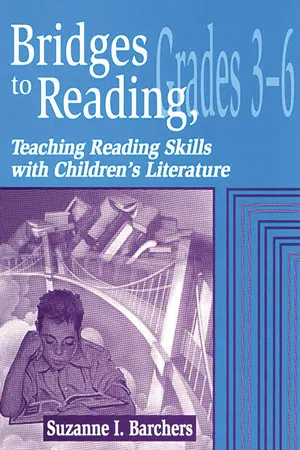
Bridges to Reading, 3-6
Teaching Reading Skills with Children's Literature
- 179 pages
- English
- PDF
- Available on iOS & Android
About this book
Now you can use quality children's literature to teach traditional reading skills! Providing a balance between traditional and literature-based instruction, these books include stimulating and instructive lessons based on approximately 150 skills commonly found in basal readers. These lessons utilize a variety of strategies that can be applied to teaching myriad skills-from alphabet and alphabetization to word recognition skills. Each featured book includes a variety of activities and a list of related books. Semantic feature analysis, attribute charts, writing activities, problem-solving, genre analysis, wordplay, and phonetic analysis are just some of the strategies covered. Wonderful tools for enlivening reading instruction, these resources reconcile the need to teach basic skills with the desire to use children's literature.
Frequently asked questions
- Essential is ideal for learners and professionals who enjoy exploring a wide range of subjects. Access the Essential Library with 800,000+ trusted titles and best-sellers across business, personal growth, and the humanities. Includes unlimited reading time and Standard Read Aloud voice.
- Complete: Perfect for advanced learners and researchers needing full, unrestricted access. Unlock 1.4M+ books across hundreds of subjects, including academic and specialized titles. The Complete Plan also includes advanced features like Premium Read Aloud and Research Assistant.
Please note we cannot support devices running on iOS 13 and Android 7 or earlier. Learn more about using the app.
Information
Table of contents
- Contents
- Introduction
- Alphabet
- Alphabetization
- Auditory Discrimination
- Classification
- Comparison
- Comprehension: Creative
- Comprehension: Inferential
- Comprehension: Literal Versus Figurative
- Figurative Language
- Finding Details
- Generalization
- Genres: Biography
- Genres: Fairy and Folktales
- Genres: Fantasy
- Genres: Historical Fiction
- Genres: Informational
- Genres: Journals and Diaries
- Genres: Mystery
- Genres: Poetry
- Genres: Realistic Fiction
- Genres: Science Fiction
- Genres: Tall Tales
- Idiomatic Language
- Letter Writing
- Literary Elements and Features: Author's Purpose
- Literary Elements and Features: Characterization
- Literary Elements and Features: Conclusion
- Literary Elements and Features: Context Clues
- Literary Elements and Features: Fact
- Literary Elements and Features: Fiction
- Literary Elements and Features: Main Idea
- Literary Elements and Features: Narrative Order
- Literary Elements and Features: Parody
- Literary Elements and Features: Personification
- Literary Elements and Features: Plot Conflict
- Literary Elements and Features: Point of View
- Literary Elements and Features: Realism Versus Fantasy
- Literary Elements and Features: Setting
- Literary Elements and Features: Spin-Offs
- Literary Elements and Features: Style
- Literary Elements and Features: Subplots
- Literary Elements and Features: Theme
- Literary Elements and Features: Tone
- Metaphorical Language
- Oral Reading
- Paraphrasing
- Parts of Speech: Adjectives
- Parts of Speech: Adverbs
- Parts of Speech: Nouns
- Parts of Speech: Prepositions
- Parts of Speech: Verbs
- Phrases/Sentences
- Prediction
- Rhyme
- Sequence
- Summarization
- Text Structure: Cause/Effect
- Text Structure: Compare/Contrast
- Text Structure: Descriptive
- Text Structure: Enumerative
- Text Structure: Problem/Solution
- Text Structure: Sequential
- Visual Perception
- Vocabulary: Appreciating Words
- Vocabulary: Direct Instruction
- Vocabulary: Etymology
- Vocabulary: Indirect Instruction
- Wordplay: Alliteration
- Wordplay: Homonyms
- Wordplay: Jokes and Riddles
- Wordplay: Onomatopoeia
- Word Recognition: Decoding
- Word Recognition: Function Words
- Word Recognition: Phonemic Awareness
- Word Recognition: Sight Words
- Appendix
- Index of Authors and Titles
- About the Author